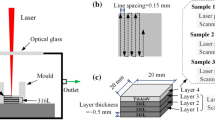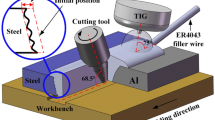Abstract
Intermetallic compounds produced in laser additive manufacturing are the main factors restricting the joint performance of dissimilar metals. To solve this problem, a dual molten pool interface interlocking mechanism was proposed in this study. Based on a dual molten pool interface interlocking mechanism, the dissimilar metals, aluminum alloy and stainless steel, were produced as single-layer and multilayer samples, using the wire-feed laser additive manufacturing directed energy deposition technology. The preferred parameters for the dual molten pool interface interlocking mechanism process of the dissimilar metals, aluminum alloy and stainless steel, were obtained. The matching relationship between the interface connection of dissimilar metals and the process parameters was established. The results demonstrated excellent mechanical occlusion at the connection interface and no apparent intermetallic compound layer. Good feature size and high microhardness were observed under a laser power of 660 W, a wire feeding speed of 55 mm/s, and a platform moving speed of 10 mm/s. Molecular dynamics simulations demonstrated a faster rate of aluminum diffusion in the aluminum alloy substrate to stainless steel under the action of the initial contact force than without the initial contact force. Thus, the dual molten pool interface interlocking mechanism can effectively reduce the intermetallic compound layer when dissimilar metals are connected in the aerospace field.
Similar content being viewed by others
References
Li Q, Xu C, Gao S, et al. Research on the forming quality of clinched joint for dissimilar sheet metal. Int J Adv Manuf Technol, 2022, 119: 2945–2959
Zhang C, Gou R, Yu M, et al. Mechanical and fatigue properties of self-piercing riveted joints in high-strength steel and aluminium alloy. J Iron Steel Res Int, 2017, 24: 214–221
Liu X, Lan S, Ni J. Analysis of process parameters effects on friction stir welding of dissimilar aluminum alloy to advanced high strength steel. Mater Des, 2014, 59: 50–62
Simar A, Avettand-Fènoël M N. State of the art about dissimilar metal friction stir welding. Sci Tech Welding Joining, 2017, 22: 389–403
Hu Y, He X, Yu G, et al. Heat and mass transfer in laser dissimilar welding of stainless steel and nickel. Appl Surf Sci, 2012, 258: 5914–5922
Wang Y L, Jiang P, Geng S N, et al. Spatial distribution of laser energy and its influence on the stability of extreme narrow keyholes during ultra-high power laser welding. Sci China Tech Sci, 2022, 65: 2079–2088
Chen X, Su C, Wang Y, et al. Cold metal transfer (CMT) based wire and arc additive manufacture (WAAM) system. J Surf Invest, 2018, 12: 1278–1284
Wu Q, Lu J, Liu C, et al. Obtaining uniform deposition with variable wire feeding direction during wire-feed additive manufacturing. Mater Manufacturing Processes, 2017, 32: 1881–1886
Liu J, Zhao S, Zhang X, et al. A laser-shock-enabled hybrid additive manufacturing strategy with molten pool modulation of Fe-based alloy. J Manufacturing Processes, 2022, 82: 657–664
Khodabakhshi F, Farshidianfar M H, Bakhshivash S, et al. Dissimilar metals deposition by directed energy based on powder-fed laser additive manufacturing. J Manufacturing Processes, 2019, 43: 83–97
Ding D, Pan Z, Cuiuri D, et al. Wire-feed additive manufacturing of metal components: Technologies, developments and future interests. Int J Adv Manuf Technol, 2015, 81: 465–481
Ramalho A, Santos T G, Bevans B, et al. Effect of contaminations on the acoustic emissions during wire and arc additive manufacturing of 316L stainless steel. Additive Manufacturing, 2022, 51: 102585
Wang P, Chen X, Pan Q, et al. Laser welding dissimilar materials of aluminum to steel: An overview. Int J Adv Manuf Technol, 2016, 87: 3081–3090
Huang W, Chen S, Xiao J, et al. Laser wire-feed metal additive manufacturing of the Al alloy. Optics Laser Tech, 2021, 134: 106627
Abioye T E, Medrano-Tellez A, Farayibi P K, et al. Laser metal deposition of multi-track walls of 308LSi stainless steel. Mater Manufacturing Processes, 2017, 32: 1660–1666
Gockel J, Beuth J, Taminger K. Integrated control of solidification microstructure and melt pool dimensions in electron beam wire feed additive manufacturing of Ti-6Al-4V. Additive Manufacturing, 2014, 1–4: 119–126
Cheng K, Zhang M B, Song H, et al. Additive manufacturing of Ti-6Al-4V alloy by hybrid plasma-arc deposition and microrolling: Grain morphology, microstructure, and tensile properties. Sci China Tech Sci, 2022, 65: 849–857
Sun H, Chu X, Luo C, et al. Selective laser melting for joining dissimilar materials: Investigations of interfacial characteristics and in situ alloying. Metall Mater Trans A, 2021, 52: 1540–1550
Syed W U H, Pinkerton A J, Li L. A comparative study of wire feeding and powder feeding in direct diode laser deposition for rapid prototyping. Appl Surf Sci, 2005, 247: 268–276
Yang J, Oliveira J P, Li Y, et al. Laser techniques for dissimilar joining of aluminum alloys to steels: A critical review. J Mater Processing Tech, 2022, 301: 117443
Xia H, Tao W, Li L, et al. Effect of laser beam models on laser welding-brazing Al to steel. Optics Laser Tech, 2020, 122: 105845
Sadmai K, Kaewwichit J, Roybang W, et al. Microstructure and tensile strength of butt joint between AA6063 aluminum alloy and AISI304 stainless steel by friction stir welding. Int J Adv Culture Tech, 2015, 3: 179–187
Sun J, Yan Q, Gao W, et al. Investigation of laser welding on butt joints of Al/steel dissimilar materials. Mater Des, 2015, 83: 120–128
Yang J, Li Y, Zhang H. Microstructure and mechanical properties of pulsed laser welded Al/steel dissimilar joint. Trans Nonferrous Met Soc China, 2016, 26: 994–1002
Pouranvari M. Critical assessment 27: Dissimilar resistance spot welding of aluminium/steel: Challenges and opportunities. Mater Sci Tech, 2017, 33: 1705–1712
Movahedi M, Kokabi A H, Reihani S M S, et al. Effect of tool travel and rotation speeds on weld zone defects and joint strength of aluminium steel lap joints made by friction stir welding. Sci Tech Welding Joining, 2012, 17: 162–167
Madhavan S, Kamaraj M, Vijayaraghavan L, et al. Microstructure and mechanical properties of aluminium/steel dissimilar weldments: effect of heat input. Mater Sci Tech, 2017, 33: 200–209
Zhao Y, Long Y, Li Z. Research progress of transition layer and filler wire for laser welding of steel and aluminum dissimilar metals. Int J Adv Manuf Technol, 2022, 119: 4149–4158
Tey C F, Tan X, Sing S L, et al. Additive manufacturing of multiple materials by selective laser melting: Ti-alloy to stainless steel via a Cu-alloy interlayer. Additive Manufacturing, 2020, 31: 100970
Pardal G, Ganguly S, Williams S, et al. Dissimilar metal joining of stainless steel and titanium using copper as transition metal. Int J Adv Manuf Technol, 2016, 86: 1139–1150
Yu G, Zou T, Chen S, et al. Effect mechanism of Ni coating layer on the characteristics of Al/steel dissimilar metal brazing. Mater Charact, 2020, 167: 110518
Chen S, Huang J, Ma K, et al. Influence of a Ni-foil interlayer on Fe/Al dissimilar joint by laser penetration welding. Mater Lett, 2012, 79: 296–299
Song T F, Jiang X S, Shao Z Y, et al. Microstructure and mechanical properties of vacuum diffusion bonded joints between Ti-6Al-4V titanium alloy and AISI316L stainless steel using Cu/Nb multi-inter-layer. Vacuum, 2017, 145: 68–76
Shang C, Wang C, Xu G, et al. Laser additive manufacturing of TA15 - Inconel 718 bimetallic structure via Nb/Cu multi-interlayer. Vacuum, 2019, 169: 108888
Li Y, Shen Y, Hung C H, et al. Additive manufacturing of Zr-based metallic glass structures on 304 stainless steel substrates via V/Ti/Zr intermediate layers. Mater Sci Eng-A, 2018, 729: 185–195
Li W, Karnati S, Kriewall C, et al. Fabrication and characterization of a functionally graded material from Ti-6Al-4V to SS316 by laser metal deposition. Additive Manufacturing, 2017, 14: 95–104
Lu H, Zhang X, Liu J, et al. Study on laser shock modulation of melt pool in laser additive manufacturing of FeCoCrNi high-entropy alloys. J Alloys Compd, 2022, 925: 166720
Lu H, He Y, Zhao Z, et al. Strengthening CoCrFeNi high entropy alloys via additive manufacturing with laser shock modulation of melt pool. Mater Sci Eng-A, 2022, 860: 144295
Wang L, Zhang Y, Yan W. Evaporation model for keyhole dynamics during additive manufacturing of metal. Phys Rev Appl, 2020, 14: 064039
Du J, Wang X, Bai H, et al. Numerical analysis of fused-coating metal additive manufacturing. Int J Thermal Sci, 2017, 114: 342–351
Yang J, Hu A, Li Y, et al. Heat input, intermetallic compounds and mechanical properties of Al/steel cold metal transfer joints. J Mater Processing Tech, 2019, 272: 40–46
Wang C, Cui L, Mi G, et al. The influence of heat input on microstructure and mechanical properties for dissimilar welding of galvanized steel to 6061 aluminum alloy in a zero-gap lap joint configuration. J Alloys Compd, 2017, 726: 556–566
Nguyen V, Nguyen Q, Huang S C. Microstructure and mechanical properties of butt joints between stainless steel SUS304l and aluminum alloy A6061-T6 by TIG welding. Materials, 2018, 11: 1136
Yang Y. Laser welding of dissimilar metal of aluminium and steel (in Chinese). Dissertation for the Master’s Degree. Changchun: Changchun University of Science and Technology, 2011. 40–41
Yasuyama M, Ogawa K, Taka T. Spot welding of aluminium and steel sheet with an insert of aluminium clad steel sheet: Dissimilar metal joining of aluminium and steel sheet (1st Report). Welding Int, 1996, 10: 963–970
Chuaiphan W, Srijaroenpramong L. Effect of welding speed on microstructures, mechanical properties and corrosion behavior of GTA-welded AISI 201 stainless steel sheets. J Mater Processing Tech, 2014, 214: 402–408
Author information
Authors and Affiliations
Corresponding authors
Additional information
This work was supported by the National Natural Science Foundation of China (Grant No. 51901162). The authors thank the support of the National Talent Program of China.
Supporting information
The supporting information is available online at tech.scichina.com and link.springer.com. The supporting materials are published as submitted, without typesetting or editing. The responsibility for scientific accuracy and content remains entirely with the authors.
Rights and permissions
About this article
Cite this article
He, Y., Zhang, X., Zhao, Z. et al. Wire-feed laser additive manufacturing of dissimilar metals via dual molten pool interface interlocking mechanism. Sci. China Technol. Sci. 66, 976–986 (2023). https://doi.org/10.1007/s11431-022-2303-x
Received:
Accepted:
Published:
Issue Date:
DOI: https://doi.org/10.1007/s11431-022-2303-x




